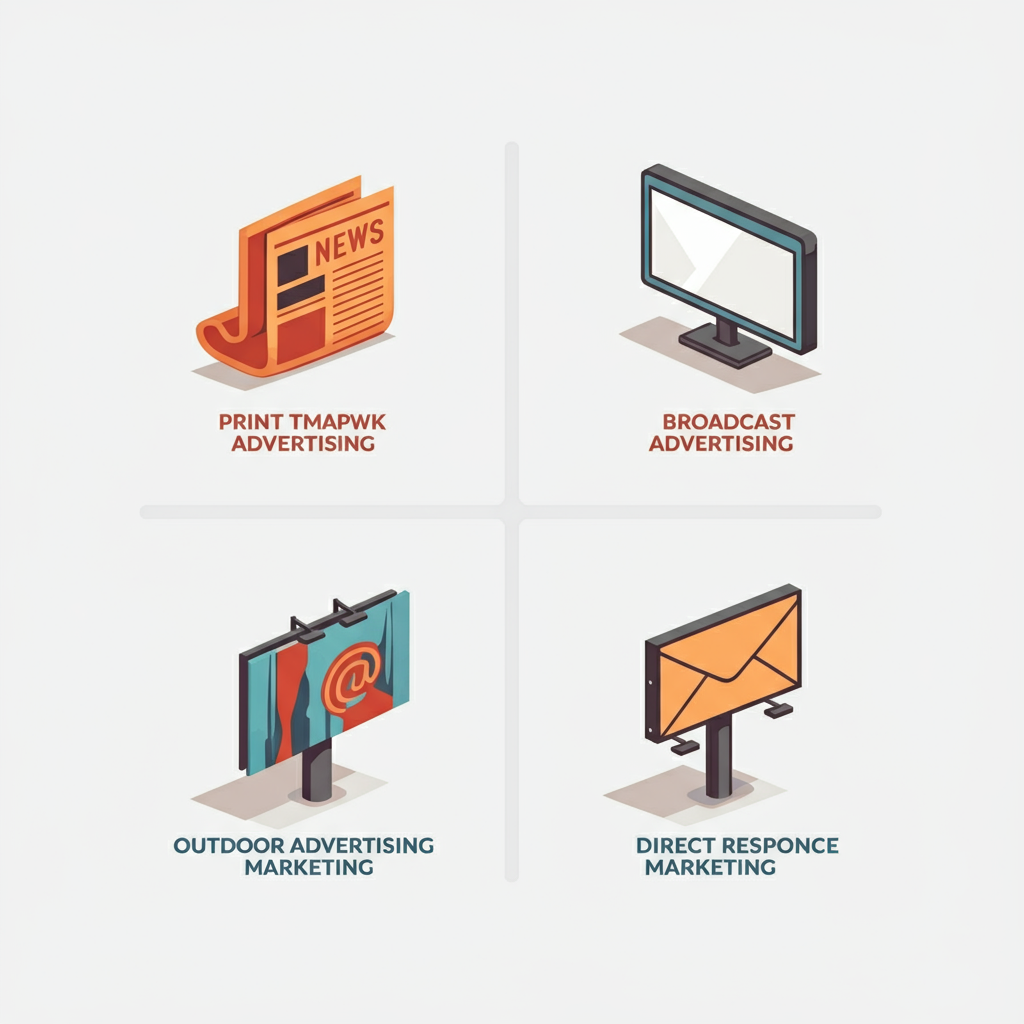
Traditional marketing has shaped how businesses connect with customers for decades. While digital channels dominate modern strategies, understanding the foundational elements of traditional marketing remains crucial for creating comprehensive campaigns that reach audiences across multiple touchpoints.
The four core elements of traditional marketing—often called the traditional marketing mix—provide a framework that continues to influence how brands communicate with consumers. These elements work together to create cohesive strategies that build awareness, generate leads, and drive sales through established channels that have proven their effectiveness over time.
What is Traditional Marketing?
Traditional marketing refers to conventional promotional methods that existed before the digital revolution. These approaches rely on established media channels and communication methods to reach target audiences through print, broadcast, and outdoor advertising platforms.
Unlike digital marketing, which offers real-time interaction and immediate feedback, traditional marketing focuses on broad reach and brand building through one-way communication channels. These methods have demonstrated lasting power in creating brand awareness and establishing credibility with consumers.
The effectiveness of traditional marketing lies in its ability to reach audiences who may not be actively searching for products or services online. It interrupts daily routines and captures attention through strategic placement in high-traffic locations and popular media consumption times.
The Four Elements of Traditional Marketing

1. Print Advertising
Print advertising encompasses newspapers, magazines, brochures, flyers, and direct mail pieces. This element relies on written content and visual design to communicate brand messages through physical publications.
Newspapers offer a broad local reach and credibility through established editorial content. Business advertisements in newspapers benefit from the trust readers place in their preferred publications. Local businesses particularly benefit from newspaper advertising because it targets specific geographic markets effectively.
Magazines provide targeted reach to specific demographics and interests. Trade publications reach professional audiences, while consumer magazines connect with hobbyists and lifestyle-focused readers. The high-quality printing and longer shelf life of magazines make them ideal for showcasing detailed product information and premium brand positioning.
Direct Mail delivers personalized messages directly to consumers’ homes. This format allows for detailed product explanations, special offers, and targeted geographic or demographic selection. Despite digital alternatives, direct mail continues to generate strong response rates, particularly for local businesses and high-value products.
Brochures and Flyers serve as portable marketing tools that provide detailed information about products or services. These materials work effectively at trade shows, retail locations, and sales presentations where potential customers can review information at their own pace.
2. Broadcast Advertising
Broadcast advertising includes television and radio commercials that reach audiences through electronic media transmission. This element combines audio and visual elements to create memorable brand experiences.
Television Advertising remains one of the most powerful traditional marketing methods. It combines visual storytelling, sound, and motion to create compelling narratives that build emotional connections with viewers. Television commercials can demonstrate product features, showcase brand personality, and reach massive audiences simultaneously.
The effectiveness of television advertising comes from its ability to target specific demographics through program selection and time slot purchasing. Morning shows reach different audiences than evening dramas, allowing advertisers to align their messages with appropriate viewer segments.
Radio Advertising provides cost-effective reach through audio messaging. Radio commercials can be produced quickly and modified easily, making them ideal for time-sensitive promotions and local market targeting. The intimate nature of radio listening creates personal connections between brands and consumers.
Radio’s strength lies in its ability to reach audiences during daily routines—commuting, working, or relaxing at home. This consistent presence helps build brand familiarity and recall through repeated exposure.
3. Outdoor Advertising
Outdoor advertising places promotional messages in public spaces where consumers encounter them during daily activities. This element captures attention through strategic placement and high-visibility displays.
Billboards represent the most recognizable form of outdoor advertising. These large-format displays appear along highways, major roads, and urban areas where they can achieve maximum visibility. Traditional billboards feature static content that remains consistent throughout the campaign period, while digital billboards rotate multiple advertisements and allow real-time content updates.
Transit Advertising reaches commuters and travelers through public transportation systems. Bus advertisements, subway displays, and airport signage target audiences during travel times when they have extended exposure to marketing messages. This format works particularly well for reaching urban populations who rely on public transportation.
Street Furniture integrates promotional messages into functional urban infrastructure. Bus shelters, kiosks, and bench advertising provide utility while showcasing brand messages. These formats often appear in high-traffic pedestrian areas where they can capture the attention of walking consumers.
The power of outdoor advertising lies in its 24/7 exposure and inability to be ignored or blocked. Unlike other traditional marketing elements that consumers can avoid, outdoor advertisements reach audiences whether they’re actively seeking marketing messages or not.
4. Direct Response Marketing
Direct response marketing creates immediate pathways for consumer action through targeted communication that encourages specific responses. This element focuses on measurable results and customer engagement.
Direct Mail Campaigns combine targeted messaging with clear calls-to-action that prompt immediate responses. These campaigns often include special offers, limited-time promotions, or exclusive access to products and services. The physical nature of direct mail allows for creative formats and premium presentations that digital alternatives cannot match.
Telemarketing provides direct personal communication between businesses and potential customers. When executed professionally and ethically, telemarketing can build relationships, answer questions, and guide prospects through the sales process. This method works particularly well for complex products or services that benefit from personal explanation.
Print Advertisements with Response Mechanisms include coupons, phone numbers, and mail-in forms that enable immediate customer action. These advertisements bridge the gap between brand awareness and direct sales by providing clear next steps for interested consumers.
Event Marketing creates face-to-face interactions between brands and customers through trade shows, conferences, and promotional events. These experiences allow for product demonstrations, personal relationship building, and immediate sales opportunities.
How the Four Elements Work Together
The four elements of traditional marketing create synergistic effects when combined strategically. Print advertising can drive awareness that broadcast advertising reinforces, while outdoor advertising maintains visibility between other media exposures. Direct response marketing then converts this accumulated awareness into measurable actions.
Sequential Messaging allows different elements to tell complete brand stories across multiple touchpoints. A consumer might first notice a billboard advertisement, then see a television commercial that provides more detail, and finally receive a direct mail piece that offers a specific call-to-action.
Frequency and Reach Optimization become possible when multiple elements work together. Each element reaches different segments of the target audience at various times, creating multiple opportunities for message exposure and retention.
Credibility Building occurs through consistent messaging across trusted traditional channels. When consumers see the same brand message in newspapers, on television, and through direct mail, the repeated exposure builds familiarity and trust.
Advantages of Traditional Marketing Elements

Established Credibility
Traditional marketing channels have built consumer trust over decades of use. Newspapers, television stations, and radio programs have established editorial standards and audience relationships that benefit advertisers through association.
Broad Reach Capabilities
Each traditional marketing element can reach large audiences efficiently. Television commercials can reach millions of viewers simultaneously, while newspaper advertisements connect with entire metropolitan areas through single placements.
Tangible Brand Presence
Print materials and outdoor displays create physical brand presence that consumers can touch, keep, and reference later. This tangibility often creates stronger memory connections than digital alternatives.
Demographic Targeting
Traditional marketing elements offer sophisticated demographic targeting through media selection and geographic placement. Different publications, programs, and locations attract specific audience segments that align with advertiser objectives.
Challenges and Considerations
Measurement Limitations
Traditional marketing elements often provide less precise measurements than digital alternatives. While circulation numbers and viewership ratings offer general reach estimates, tracking specific conversions and engagement levels can be challenging.
Higher Production Costs
Creating professional television commercials, print advertisements, and outdoor displays requires significant investment in creative development, production, and media placement. These costs can be prohibitive for smaller businesses with limited marketing budgets.
Longer Lead Times
Traditional marketing campaigns typically require weeks or months for planning, production, and placement. This timeline makes it difficult to respond quickly to market changes or time-sensitive opportunities.
Limited Interactivity
Most traditional marketing elements provide one-way communication that doesn’t allow for immediate consumer feedback or engagement. This limitation can make it challenging to build relationships and address customer concerns in real time.
Integration with Modern Marketing Strategies
Cross-Channel Campaigns
Successful modern marketing strategies often integrate traditional elements with digital channels to create comprehensive campaigns. QR codes on print advertisements can drive traffic to websites, while social media hashtags in television commercials encourage online engagement.
Brand Consistency
Traditional marketing elements provide opportunities to reinforce brand messages and visual identity across multiple touchpoints. Consistent use of logos, colors, and messaging across print, broadcast, and outdoor advertising builds stronger brand recognition.
Customer Journey Support
Different traditional marketing elements can support various stages of the customer journey. Outdoor advertising might create initial awareness, while direct mail campaigns nurture leads and encourage conversions.
Maximizing Traditional Marketing Success
Understanding and effectively implementing the four elements of traditional marketing requires strategic planning and careful execution. Each element offers unique strengths that can contribute to comprehensive marketing success when properly integrated.
Budget Allocation should reflect the relative strengths of each element for specific campaign objectives. Brand awareness campaigns might emphasize broadcast and outdoor advertising, while direct response campaigns focus on print and direct mail elements.
Creative Excellence remains crucial across all traditional marketing elements. Professional design, compelling messaging, and clear calls to action determine the effectiveness of any traditional marketing campaign.
Timing and Frequency considerations vary by element and target audience. Television advertising might require sustained campaigns to build awareness, while direct mail can generate immediate responses through strategic timing.
The enduring effectiveness of traditional marketing elements demonstrates their continued relevance in comprehensive marketing strategies. By understanding how print advertising, broadcast advertising, outdoor advertising, and direct response marketing work individually and together, businesses can create powerful campaigns that reach audiences across multiple touchpoints and drive meaningful results.
Learn more about: What Is Viral Marketing? A Beginner’s Guide to Going Big









Leave a Reply